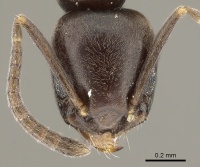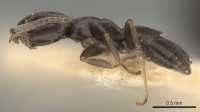Tapinoma kinburni
| Tapinoma kinburni | |
|---|---|

| |
| Scientific classification | |
| Kingdom: | Animalia |
| Phylum: | Arthropoda |
| Class: | Insecta |
| Order: | Hymenoptera |
| Family: | Formicidae |
| Subfamily: | Dolichoderinae |
| Genus: | Tapinoma |
| Species: | T. kinburni |
| Binomial name | |
| Tapinoma kinburni Karavaiev, 1937 | |
This species was found in semi-open sandy areas covered by xerophile plants and interspersed with small salt lakes and stands of arboreal relict flora such as Pedunculate Oak and Silver Birch. The nests are in soil, in patches with incomplete turf cover and have entrance holes of 2–4 mm diameter which are often surrounded by crater-like sand ejections of up to 8 cm diameter. Foraging is diurnal and only interrupted during the hottest post-meridiem hours. Alates were observed between 16 June and 20 July. (Seifert et al. (2024), according to Karavaiev (1937) and Radchenko (1983)).
Identification
Seifert et al. (2024) - Worker (Tab. 7, Figs. 21–23): All shape ratios given below are primary ratios without RAv and all data are given as arithmetic mean ± standard deviation (n-weighted). Small size, CS 586 ± 24 µm. Head moderately elongated CL/CW 1.137 ± 0.024. Postocular distance medium-sized, PoOc/CL 0.435 ± 0.008. Anteromedian clypeal excision shallow and broad, ExCly/CS 2.96 ± 0.30 %, ExClyW 8.12 ± 0.84 %. Pubescence hairs and fine setae protruding at a few micron across margin of clypeal excision usually absent, nExCly 0.43 ± 0.53; clypeus margin lateral of the excision with 3–5 long and 3–4 shorter setae. Posterior margin of head not or only very slightly excavated, ExOcc/CS 0.73 ± 0.47 %. Scape short, SL/CS 0.24 ± 0.013. Second funiculus segment very short, Fu2L/CS 10.18 ± 0.35 %, IFu2 1.141 ± 0.068. Minimum distance of the inner margins of antennal socket medium sized, dAN/CS 0.303 ± 0.005. Eye moderately large, EL/CS 0.273 ± 0.006. Mesosoma relatively narrow and rather short, MW/CS 0.631 ± 0.011, ML/CS 1.219 ± 0.036. Metanotal depression rather shallow, MGr/CS 2.47 ± 0.38 %. Whole body homogeneously dark to blackish brown; metatarsae, tarsae, distal end of scape and often mandible pale yellowish brown.
Male genital: see drawings in Radchenko (1983).
As a combination of small size, short scape and second funiculus segment, and shallow clypeal excision not to confuse. Nanitic workers of Tapinoma subboreale, which have a similar body size, can be distinguished by SL/CS > 0.970 and Fu2L/CS > 0.117.
Keys including this Species
Distribution
Seifert et al. (2024) - So far only known from the type locality and a site near to the Korsun Monastery (46.76°N, 33.19°E).
Latitudinal Distribution Pattern
Latitudinal Range: 46.462° to 46.462°.
| North Temperate |
North Subtropical |
Tropical | South Subtropical |
South Temperate |
- Source: Seifert et al. (2024)
Distribution based on Regional Taxon Lists
Palaearctic Region: Russian Federation, Ukraine (type locality).
Distribution based on AntMaps
Distribution based on AntWeb specimens
Check data from AntWeb
Countries Occupied
| Number of countries occupied by this species based on AntWiki Regional Taxon Lists. In general, fewer countries occupied indicates a narrower range, while more countries indicates a more widespread species. |

|
Estimated Abundance
| Relative abundance based on number of AntMaps records per species (this species within the purple bar). Fewer records (to the left) indicates a less abundant/encountered species while more records (to the right) indicates more abundant/encountered species. |

|
Biology
Flight Period
| X | X | ||||||||||
| Jan | Feb | Mar | Apr | May | Jun | Jul | Aug | Sep | Oct | Nov | Dec |
Source: Seifert et al., 2024.
- Check details at Worldwide Ant Nuptial Flights Data, AntNupTracker and AntKeeping.
 Explore: Show all Flight Month data or Search these data. See also a list of all data tables or learn how data is managed.
Explore: Show all Flight Month data or Search these data. See also a list of all data tables or learn how data is managed.
Castes
Nomenclature
The following information is derived from Barry Bolton's Online Catalogue of the Ants of the World.
- kinburni. Tapinoma kinburni Karavaiev, 1937: 174, figs. 3, 4 (w.) UKRAINE. Radchenko, 1983: 1905 (q.m.).
Type Material
Seifert et al. (2024) - The species was described from Zolonoozerna Dacha (46.462°N, 32.159°E, 3 m), 6 km W of Rybalche, Kinburn penisula, Ukraine. The diagnosis presented here is based on investigation of the image CASENT0917470 of the neotype and of three worker series from the type locality.
Description
References
- Borowiec, L. 2014. Catalogue of ants of Europe, the Mediterranean Basin and adjacent regions (Hymenoptera: Formicidae). Genus (Wroclaw) 25(1-2): 1-340.
- Dubovikoff, D.A., Yusupov, Z.M. 2017. Family Formicidae - Ants. In Belokobylskij S. A. and A. S. Lelej: Annotated catalogue of the Hymenoptera of Russia. Proceedingss of the Zoological Institute of the Russian Academy of Sciences 6: 197-210.
- Karavaiev, V. 1937. Ants collected in the nature reserves of Kinburnskaya Peninsula and Burkuty. Zb. Prats Zool. Muz. 19: 171-181 (page 174, figs. 3, 4 worker described)
- Radchenko, A. G. 1983. Tapinoma kinburni (Hymenoptera, Formicidae), endemic species of Ukrainian fauna. Zool. Zh. 6 62: 1904-1907 (page 1905, queen, male described)
- Radchenko, A.G., Fisher, B.L., Esteves, F.A., Martynova, E.V., Bazhenova, T.N., Lasarenko, S.N. 2023. Ant type specimens (Hymenoptera, Formicidae) in the collection of Volodymyr Opanasovych Karawajew. Communication 1. Dorylinae, Poneromorpha and Pseudomyrmecinae. Zootaxa, 5244(1), 1–32 (doi:10.11646/zootaxa.5244.1.1).
- Seifert, B. 2016. Clypeal excision in Tapinoma Förster, 1850 ants is adaptive (Hymenoptera: Formicidae). Contributions to Entomology 66, 125-129 (doi:10.21248/CONTRIB.ENTOMOL.66.1.125-129).
- Seifert, B., Kaufmann, B., Fraysse, L. 2024. A taxonomic revision of the Palaearctic species of the ant genus Tapinoma Mayr 1861 (Hymenoptera: Formicidae). Zootaxa 5435(1), 1-74 (doi:10.11646/zootaxa.5435.1.1).
References based on Global Ant Biodiversity Informatics
- Borowiec L. 2014. Catalogue of ants of Europe, the Mediterranean Basin and adjacent regions (Hymenoptera: Formicidae). Genus (Wroclaw) 25(1-2): 1-340.
- Czechowski W., A. Radchenko, W. Czechowska and K. Vepsäläinen. 2012. The ants of Poland with reference to the myrmecofauna of Europe. Fauna Poloniae 4. Warsaw: Natura Optima Dux Foundation, 1-496 pp
- Dubovikoff D. A., and Z. M. Yusupov. 2018. Family Formicidae - Ants. In Belokobylskij S. A. and A. S. Lelej: Annotated catalogue of the Hymenoptera of Russia. Proceedingss of the Zoological Institute of the Russian Academy of Sciences 6: 197-210.

